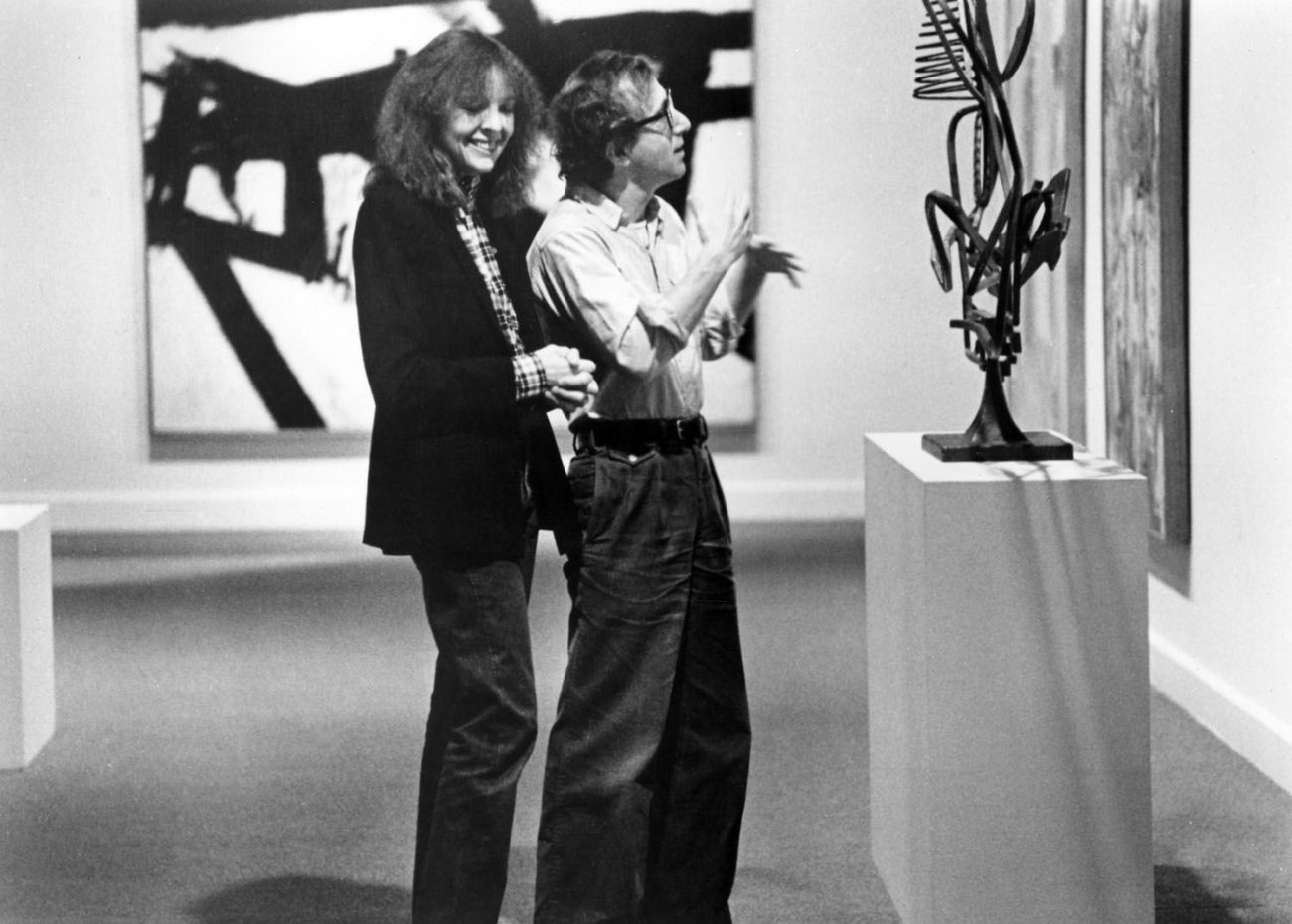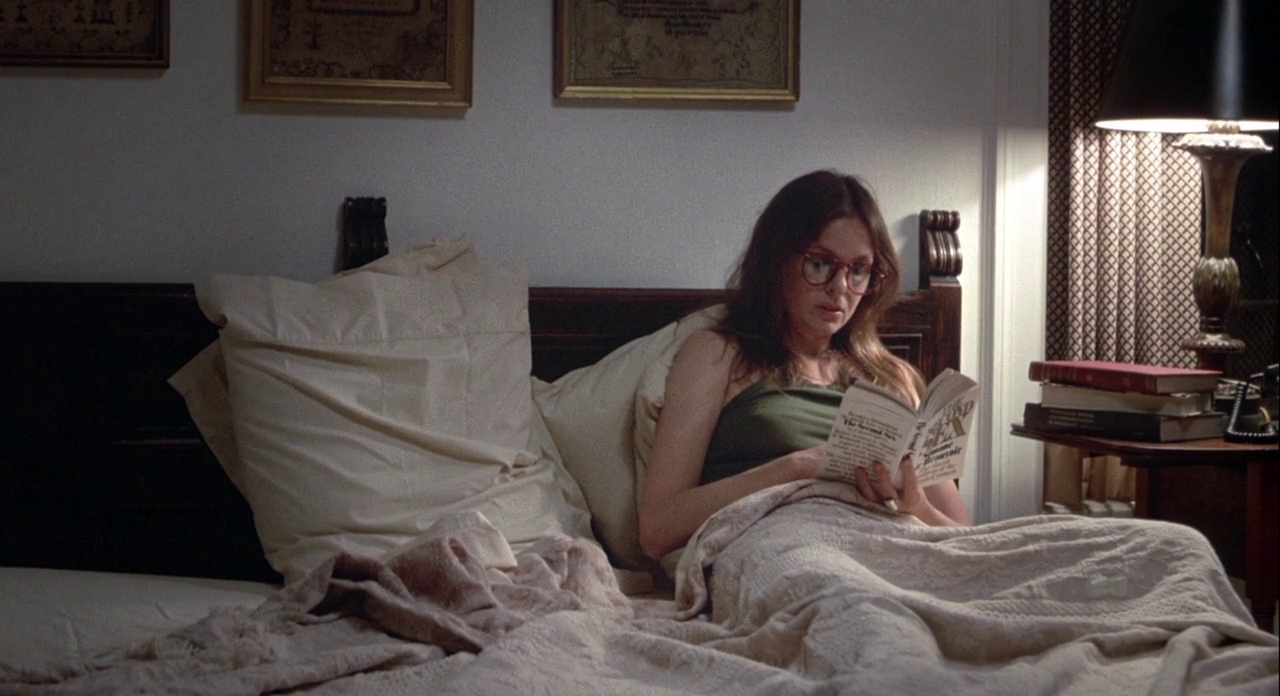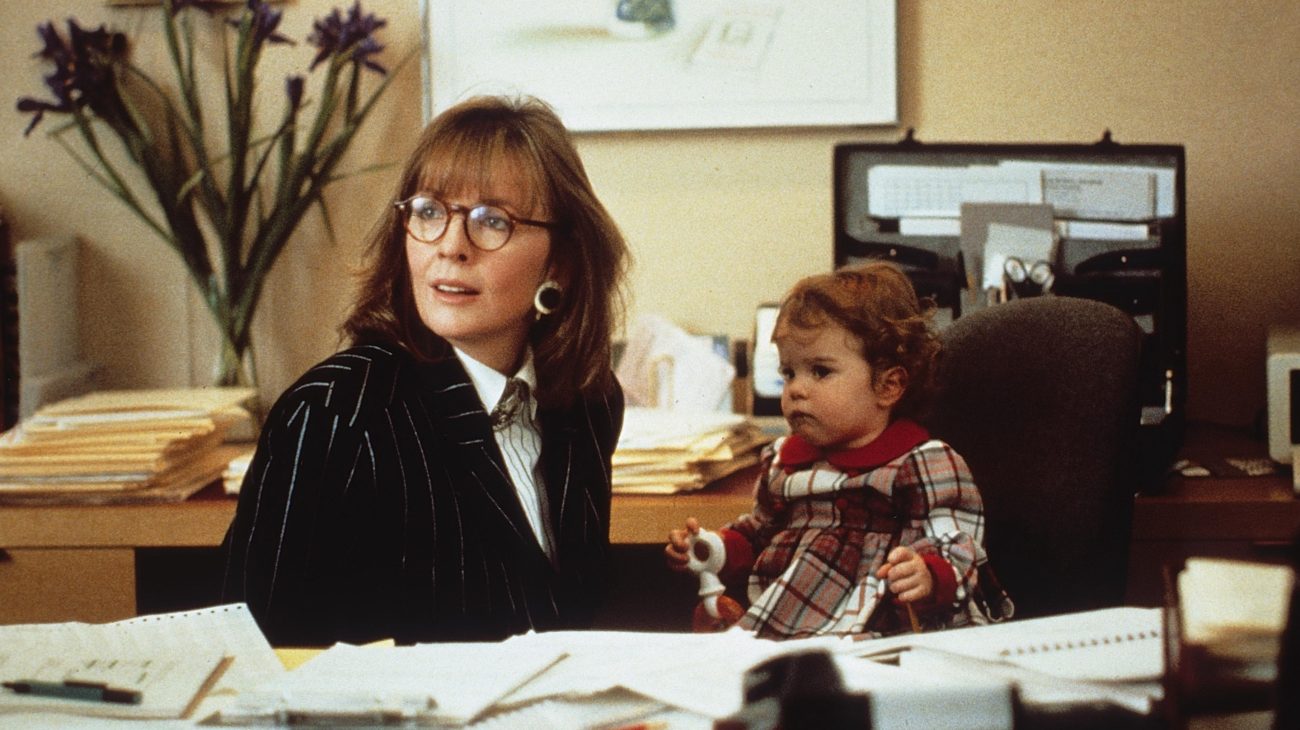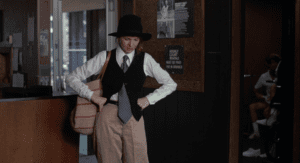For most movie viewers, Diane Keaton is synonymous with Annie Hall, her 1977 collaboration with Woody Allen. And for good reason. Annie is largely based on Keaton herself, and the film is inspired, in large part, by her and Allen’s relationship. In the film, Allen plays Alvin Singer, a stand-up comic who is struggling with his love life. He’s in love with Annie, who becomes a sort of protégée. When they meet, Annie wears a thrift shop harmony of khaki trousers, a waistcoat, and a large floppy tie (handed down from her grandfather). Her long brown hair is gathered beneath a masculine bowler hat. In retrospect, this outfit – a charming, kooky, “safe” form of androgyny – is as iconic and important as the film itself. Furthermore, because there’s so much Diane Keaton in Annie Hall, it becomes difficult to cleeve the two.
In the 1970s, when Keaton experienced her first flush of critical acclaim as a movie star, she was called the “next Hepburn.” Like Katharine Hepburn, she was a style icon and a quasi-masculine symbol of feminine individuality: She was beautiful, funny, and (most importantly) relatable. As Annie Hall, Keaton followed in the footsteps of actresses like Marlene Dietrich, Greta Garbo, and Hepburn, exemplifying the exciting, scary, and new opportunities that women faced after the sexual revolution. Indeed, as Annie, Keaton’s costuming is not unlike Dietrich’s masculine drag. She represents a shift in the discourse on femininity and what it means to be a self-defined woman. Though Alvy wants Annie to be his protégée – giving her books to read, sending her to an analyst, encouraging her to go to school – Annie eventually outgrows him. Like many women who grew up during the sexual revolution and second-wave feminism, she evolves. Her existence isn’t reliant on Alvy’s, and, in fact, after the two eventually split up, she is seemingly better for it.

In Allen’s Manhattan (1979), Keaton inhabits her second most iconic role as the abrasively intellectual, Mary Wilkie. Mary Wilkie lacks the naivety of Annie Hall, and this change is strongly reflected in Mary’s garb of suit jackets and oversized blazers. But there’s a shabby elegance to Mary Wilke, befitting a writer, and it’s not as stylized as Annie Hall’s look. This role represents a darker facet of Keaton’s comedic persona, but the main difference between Annie and Mary is that Annie feels as if she’s growing and learning, and is finding the world to be a bit of a lark. Mary, on the other hand, feels as if she’s got a lot of the answers. What Manhattan presents is a new facet to Keaton’s comedic range, one that isn’t reliant on goofy charm, but caustic wit.
In Charles Shyer’s 1987 comedy Baby Boom, Keaton’s comedic persona and her aesthetic are subjected to a trendy, 1980s filter. Keaton plays J.C. Wiatt, the ultimate yuppie. In the film, J.C. is a hyper-competent and career-driven woman who improbably inherits a baby. Like Annie and Mary, J.C. is a New Yorker through and through – a New Yorker, defined totally by her New Yorker-ness. And so, Keaton’s wardrobe isn’t as free to improvisation as it was when she played the free-spirited Annie. She appears in the film in designer suits, cinched at the waist with large belts.
Though Keaton’s earlier incarnations embraced androgyny, there’s a contradictory masculinity to her look as J.C. We can see J.C.’s legs – something that’s rare for a Diane Keaton character, who appears practically swaddled in jackets, sweaters, scarves, and hats. J.C. operates in a male-dominated world, and as such, she appears to be playing catch up. The costuming in Baby Boom is certainly stylized, skewed to reflect Keaton’s strange style, but it’s also adapted to reflect her character’s world and the time in which she’s living. J.C.’s independence is defined by her job, her initial indifference to instant motherhood, and her much commented-upon toughness. Unlike Annie – or Mary, for that matter – J.C.’s independence is telegraphed, and it feels a bit more forced and dependant on trendy plot points. After all, Shyer’s production is very much of its time: synth-laden soundtrack, the treatment of the female labor force as a novel idea, the plot trope of a busy career person suddenly becoming a parent. It’s one of the reasons why J.C. doesn’t endure or age as well as Annie Hall or Mary Wilkes.
Part of why Keaton’s clothing is so important when assessing her impact as a comedienne is because clothing is often an important element of establishing a comedic character. In fact, the archetypical Diane Keaton look – the loose, baggy man’s outfit – is very reminiscent of Charlie Chaplin’s Tramp. It’s not surprising that in the Venn diagram of film, Annie Hall and Chaplin intersect, as he’s a looming influence on Woody Allen. Film historian and critic, Christopher Frayling wrote of Chaplin’s Tramp costume:
Charlie Chaplin’s costume as ”the Tramp’’ is a bundle of contradictions: the jacket is buttoned too tightly, the trousers are too baggy, the bowler hat too small and the size 14 shoes much too big, as well as being worn on the wrong feet. These disparate elements combined to help define his screen personality and its place in the world, including his social pretensions.
Something very similar can be said about Keaton’s established look. The clothes reflect women who find themselves at a crossroads when it comes to women’s roles in society, culture, and film. Keaton’s characters are women who are often independent, middle-class with kinds of opportunities that generations before wouldn’t be able to enjoy. Furthermore, Keaton’s style of acting — her distinct speech patterns as well as her look — makes her very much of her time. Like most screen comics, her roles are often variations on her established self.
There’s a safe queerness to Keaton’s image. In the code days of Hollywood when queerness was forbidden, audiences were clued into it through costuming. Think of Dietrich’s power tuxedo, Garbo in Queen Christina (1933, dir. Rouben Mamoulian) or Nancy Blake (Florence Nash) in George Cukor’s 1939 The Women. Though Keaton’s drag echoes queerness, the reason it is safe is that it doesn’t subvert gender norms directly, nor does it make an explicit claim that Keaton is queer. It’s the kind of “safe” queerness that is allowed to exist because it doesn’t seek to explicitly advocate for queerness. In Billy Wilder’s classic comedy Some Like It Hot, we see various levels of drag and queerness – and the comedy comes from the characters running in and out of drag. But we’re assured that the queerness is only situational – the men in the film aren’t in drag because of self-expression, but merely because they’re on the run from the mafia. Keaton’s queerness is similar in that her sexuality is often obscured by layers of clothing. When we do see glimpse of her body – whether that’s her shapely legs in Baby Boom or her blink-and-you-miss-it nude scene in 2003’s Something’s Gotta Give (dir. Nancy Myers), the effect feels anomalous – as if her sexuality and femininity exists, hidden, only to be discovered by chance.

Going back to the comparison with Chaplin, Keaton still emerges as an example of a comedic performer in drag, a tradition that harkens back to the early years of film comedy, starting from the silent era and moving into the talkies, in which comedians such as Fatty Arbuckle, Stan Laurel, and Chaplin performed in drag to elicit laughter at the spectacle. When Keaton appears in drag as Annie, it’s funny. Not in the same way as it was supposed to be funny when the silent comedians appeared in drag (for there was a strain of homophobia laced in those works), but it’s funny nonetheless. Keaton not only recalls those great silent comedians, but she also reminds viewers of eccentric kook – like Barbra Streisand’s 1960s persona, who would appear on stage dressed in a dizzying array of haute couture clashing with her thrift store, Second Hand Rose persona.
Unlike other examples of cross-dressing women, Keaton’s characters are – for the most part – charming and silly. Their “male-ness” is a component of their quirky appeal. Ultimately, Diane Keaton’s comedy is based in being an outsider, someone who just doesn’t fit in – and doesn’t seem to mind that she’s an odd duck. And this individuality is constantly affirmed by variations on her costume. Even when she’s cast as middle-class or wealthy society ladies – as she was in the Father of the Bride films, The First Wives Club, Hanging Up or The Other Sister – she brings this oddness to her characters. Though they aren’t as goofy or silly as Annie Hall, they still manage to exert some distinct personal flair and personality, even if the script doesn’t call for it (this is especially true of Keaton’s part in the Father of the Bride films). A large part of appreciating Diane Keaton’s work as a comedienne is to appreciate the way she’s managed to construct her image through the consistency in the way that she dresses as well as how she uses her costuming to clue her audience in on her characters’ socio-economic and class positions. Ultimately, what we see in Keaton’s persona is not a wholesale rejection of traditional femininity but a broadening of it. Though she’s not an immediately political figure like Jane Fonda, she’s celebrated because of her inclination to eschew fashion trends and gendered notions of clothing while developing and creating her own inimitable style



 " alt="">
" alt="">